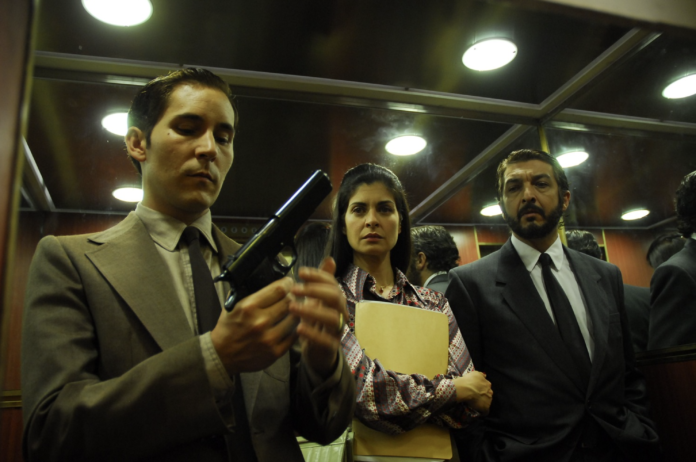As the autumnal month descends upon us and Hispanic Heritage Month approaches its midpoint, it is only fitting to delve into acclaimed films crafted by Hispanic filmmakers. Over 30% of UNLV’s students are Hispanic or Latino. As UNLV celebrates Hispanic Heritage Month, this short list comprises Hispanic- or Latino-crafted films that are readily available through UNLV libraries or easily accessible for mainstream audiences.
“Amores Perros” (2000)
A masterpiece of this caliber emerges perhaps once in a millennium. If there’s a singular film essential to understanding the landscape of Hispanic cinema, it is undoubtedly this. Its gritty, flat color palette and non-chronological storytelling vividly capture the hopelessness and claustrophobia of Mexico City. Drawing inspiration not from the witty dialogue or gleeful violence of Pulp Fiction, but from its unconventional narrative structure, the film weaves three interconnected stories: a mild-mannered young man embroiled in underground dog fighting, a magazine publisher who abandons his family for his mistress, and a disheveled hitman attempting to reunite with his estranged daughter. These narratives intricately revolve and reconvene after a violent car crash, forming a cinematic tapestry that propelled filmmaker Alejandro González Iñárritu into the limelight. Nominated for an Academy Award for Best Foreign Film and honored with the Prize of the Critic’s Week at Cannes, his extraordinary debut marks a milestone in the realm of filmmaking. “Amores Perros” can be accessed online through https://www.library.unlv.edu/.
“The Devil’s Backbone” (2001)
In the midst of the Spanish Civil War’s turmoil, a poignant tale unfolds within the walls of a disheveled orphanage, where a young soul, portrayed by Fernando Tielve, grapples with abandonment and the haunting specter of conflict. Guided by the ethereal presence of Junio Valverde’s character, the secrets woven into the orphanage’s very fabric start to unravel. Guillermo Del Toro, with his unmatched finesse, delicately melds elements of horror with profound human vulnerability in his masterpiece, “The Devil’s Backbone.” This film, a testament to Del Toro’s storytelling prowess, serves as the cornerstone upon which he would build his most celebrated work, “Pan’s Labyrinth.” In a commentary track for “The Devil’s Backbone,” Del Toro philosophizes, declaring, “War is the ultimate act of intolerance. It gives no honor. It gives no victory. There are no winners, just losers.” His words echo through the celluloid, underscoring the film’s powerful narrative about the human cost of conflict, a theme that resonates across his illustrious cinematic journey. “The Devil’s Backbone” is available online through https://www.library.unlv.edu/.
“The Young and the Damned” (1950)
To envisage a moment in time in which Luis Buñuel ceased to exist is to also imagine a moment in which Latin cinema ceases as well. A group of impoverished youth gathers around to rebel in the slums of Mexico City. After an altercation breaks out between three boys, El Jaibo (played by Roberto Cobo), the group’s leader, and his accomplice Pedro (played by Alfonso Mejia) murder a young boy in cold blood. The remainder of the film shows El Jaibo and Pedro escaping the law and their guilt. Inspired by the cultural movement of surrealism, Buñuel embeds droplets of absurdism and surrealism throughout his filmography. “The Young And The Damned” is no different. Buñuel’s surrealist style mixes with the depressing Mexico City environment, lending itself to being a unique experience of filmmaking. This extraordinary work of filmmaking is only reflected by its extraordinary achievements, having won the Palme D’or, the most sought-after award in the Cannes Film Festival, in 1951 and securing the 110th spot for the greatest films of all time according to Sight and Sound critics. “The Young and the Damned’s” rich atmosphere and characters give the film a timeless quality. The physical version of “The Young and the Damned” is available to check out from Lied Library.
“Birds of Passage” (2018)
In the 1970s, a Colombian indigenous tribe emerged as pivotal figures in the drug trade. Yet, their role as arbiters of this illicit enterprise ushered in not just wealth, but also insatiable greed, moral dishonor and a chilling apathy that seeped into the core of their community. This unsettling transformation, eerily reminiscent of the surrealist nuances in Luis Buñuel’s films, inspired Ciro Guerra and Cristina Gallego to create cinematic masterpieces deserving of museum exhibition. Each frame is meticulously composed and captures sprawling landscapes, immersing the viewer in a world of profound isolation and desolation. “Birds of Passage” magnifies the stark reality of the drug trade, bringing to the fore the chilling solitude and inevitable downfall that accompany it. This film, haunting and mesmerizing, crafts an unforgettable cinematic experience, where the very soul of a community is laid bare amidst the ruthless currents of the drug business.
“The Secret in Their Eyes” (2009)
Coming home with the Academy Award for Best Foreign Film, Juan José Campanella’s film, “The Secret in Their Eyes,” brings Argentine films to the mainstream. The last Argentine film to have any mainstream recognition was “The Official Story,” having won an Academy Award in 1985. “The Secret in Their Eyes” follows Benjamín Espósito (played by Ricardo Darín), a judiciary employee, as he attempts to unravel and solve a murder case. It has a very simple premise, similar to acclaimed films such as David Fincher’s “Seven” and Bong Joon-ho’s “Memories of Murder,” and they all have their distinctive perceptiveness. “Memories of Murder,” like “The Secret in Their Eyes,” exhibits a similar starkness in its portrayal of crime and its aftermath. “The Secret in Their Eyes,” with its tight plot and nuanced characters, solidifies its position as a masterpiece in Argentine cinema, showcasing the depth and complexity of human emotions in the face of tragedy and justice. Fincher’s “Seven,” known for its dark and gritty atmosphere, shares this exploration of the human psyche in the realm of crime, making it a fitting comparison to the nuanced storytelling found in “The Secret in Their Eyes.”

